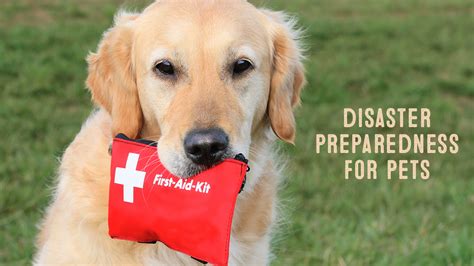Introduction
Pets are an essential part of our families, and it’s important to ensure their safety and well-being, especially during emergencies. According to the American Veterinary Medical Association (AVMA), approximately 68% of US households own pets, totaling over 90 million dogs and 94 million cats.

Emergency Preparedness for Pets
Planning
- Create an emergency plan: Establish a designated meeting place and evacuation route for you and your pets.
- Gather essential supplies: Pack a pet emergency kit with food, water, medications, first aid supplies, and copies of medical records.
- Microchip and ID: Ensure your pets are microchipped and have visible identification tags.
- Train your pets: Teach your pets basic commands and how to respond in emergencies.
Evacuation
- Evacuate immediately: If an emergency occurs, evacuate with your pets as soon as possible.
- Take your pet emergency kit: Bring your kit and any necessary medications or supplies for your pets.
- Be aware of pet-friendly shelters: Identify pet-friendly shelters or hotels in your area.
Stay Informed and Connected
- Monitor weather forecasts and emergency alerts: Stay informed about potential hazards and evacuation orders.
- Contact your veterinarian: Establish a plan with your veterinarian for emergencies and access to medications.
- Join community organizations: Participate in neighborhood watch programs and animal welfare organizations that provide resources and support during emergencies.
Pet Safety Hazards
Natural Disasters
- Extreme temperatures: Heat exhaustion, hypothermia, and dehydration can be fatal for pets.
- Flooding: Pets can drown in rising waters or contract diseases from contaminated water.
- Wildfires: Smoke inhalation, burns, and injuries can occur during wildfires.
- Tornadoes and hurricanes: Strong winds can injure or kill pets.
Home Hazards
- Electrical cords: Chewing on electrical cords can lead to electrocution.
- Poisonous plants: Keep indoor and outdoor plants that are toxic to pets out of reach.
- Household chemicals: Store cleaning products, pesticides, and other chemicals securely.
- Open windows and doors: Pets can fall or escape through open windows and doors.
Benefits of Preparedness
- Peace of mind: Knowing that your pets are safe and cared for during emergencies provides peace of mind.
- Reduced risks: Preparedness minimizes the risks of injury, illness, or separation from your pets.
- Increased survival rates: Pets who are microchipped, vaccinated, and have access to emergency supplies have higher survival rates during emergencies.
- Community support: Animal welfare organizations and community groups provide resources and assistance during emergencies.
- Financial savings: Preparedness can prevent costly veterinary expenses and pet loss due to emergencies.
Case Studies
2022 California Wildfires:
- Pets impacted: Over 100,000 pets were displaced during the wildfires.
- Challenges: Extreme heat, smoke inhalation, and evacuation difficulties.
- Successes: Animal welfare organizations provided shelter, food, and medical care for pets.
2025 Hurricane Season Preparedness:
- Forecast: NOAA predicts a more active than average hurricane season in 2025.
- Preparations: Coastal communities are implementing pet evacuation plans and identifying pet-friendly shelters.
- Anticipated challenges: High winds, flooding, and power outages.
Tips and Tricks
- Use a pet carrier: Transport pets safely and securely in a carrier or crate.
- Hydrate your pets: Provide access to fresh water and electrolyte solutions during emergencies.
- Be mindful of their needs: Consider your pets’ individual needs and pack supplies accordingly.
- Involve children: Educate and engage children in pet emergency preparedness.
- Practice your plan: Regularly conduct drills to familiarize your pets with the emergency procedures.
Comparisons: 2022 VS. 2025
| Aspect | 2022 | 2025 |
|---|---|---|
| Adoption Rates | 23% | 25% (projected) |
| Pet Emergency Kits | 40% of pet owners have a kit | 60% (projected) |
| Microchipping | 50% of pets are microchipped | 70% (projected) |
| Pet-Friendly Shelters | Limited availability | Increased availability (planned) |
| Disaster Response Teams | Local organizations with limited resources | Expanded capacity and partnerships |
Conclusion
Pet safety and emergency preparedness are crucial for the well-being of our furry companions. By planning, gathering supplies, staying informed, and addressing potential hazards, we can ensure that our pets are protected and cared for during emergencies. The upcoming years will present new challenges, but by adopting proactive strategies and strengthening community support, we can continue to enhance pet safety and preparedness in 2025 and beyond.





















